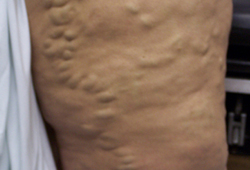History and exam
Key diagnostic factors
common
dilated tortuous veins
With the patient standing, the skin is examined visually and by palpation for irregularities and bulges consistent with varicose veins. [Figure caption and citation for the preceding image starts]: Varicose veinsFrom the collection of Maureen K. Sheehan, MD; used with permission [Citation ends]. The extent, size, and location of the dilated veins should be noted.
The extent, size, and location of the dilated veins should be noted.
Other diagnostic factors
common
leg fatigue or aching with prolonged standing
Not present at beginning of day, improves with elevation.
leg cramps
Usually nocturnal. May be related to varicose veins and thus may improve with treatment; however, can be multifactorial in etiology.
restless legs
Characterized by a compulsive urge to move the legs, though this can be multifactorial.
hemosiderin deposition
Clinical sign of venous hypertension and irreversible. It is an indication of high risk for ulceration, with the hemosiderin causing inflammation and damaging the soft tissues.
Can occur without venous incompetence in the context of morbid obesity (which reduces venous outflow).
corona phlebectatica
Multiple fine vein branches that suggest underlying chronic venous insufficiency.
uncommon
itching
Occurs with prolonged standing or exercise.
lipodermatosclerosis
Clinical sign of venous hypertension and is irreversible. It is an indication of high risk for ulceration and is the result of hemosiderin causing inflammation and damaging the soft tissues. This leads to scarred and fibrotic tissues.
ankle swelling
Detectable in affected leg with prolonged standing. This is common and represents C3 class disease.
ulceration
Varicose ulcers are indicative of long-standing venous insufficiency; however, most varicose veins do not progress to complications such as ulceration.[13]
Ulceration is an indication for urgent referral.
bleeding from varices
Patients should be asked about bleeding from the varices; however, most varicose veins do not progress to complications such as hemorrhage.[13]
This should generate an urgent referral, and still leads to occasional deaths in the frail.
Risk factors
strong
increasing age
Prevalence increases with age.[8]
family history
One of the most important risk factors for developing varicose veins. Studies in both the US and France have shown that a family history of varicose veins in an immediate family member increases the risk of developing varicose veins.[12]
female sex
The majority of studies have demonstrated a greater prevalence in women than in men; however, this may be due to presentation bias. Despite the greater prevalence in women, the presenting level of disease in men has been found to be worse.[4]
increasing numbers of births
Pregnancy increases both total body fluid and intra-abdominal pressure, which may cause venous distention. In addition, the increase in estrogen, progesterone, and relaxin increases vein capacitance by increasing venous relaxation.[12]
deep vein thrombosis
May cause valvular damage and dysfunction in the deep veins, leading to increased pressure in tributaries with subsequent distention and varicose vein formation.
Use of this content is subject to our disclaimer